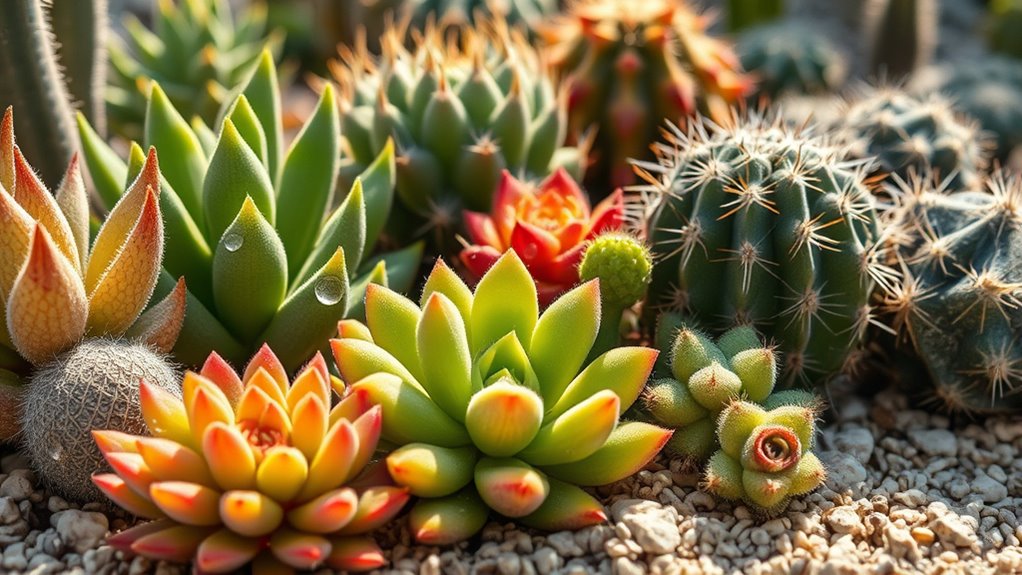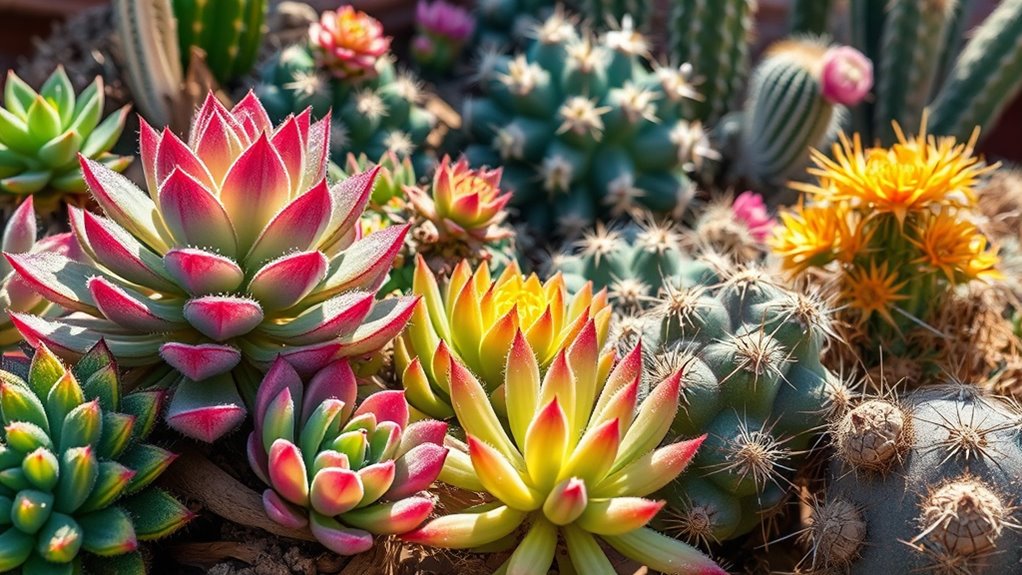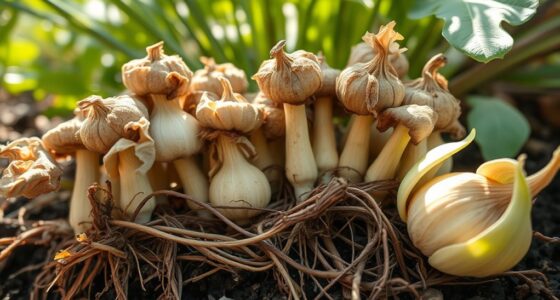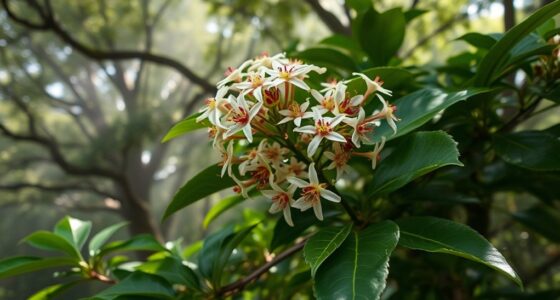During summer growth, water your rare succulents and cacti deeply but infrequently, allowing the soil to dry out completely between watering sessions. Use a well-draining soil mix and avoid pooling water around the roots. In winter dormancy, cut back on watering markedly, only watering when the soil is fully dry, to prevent rot and pests. Mastering these seasonal shifts helps keep your plants healthy—stay with us to learn more about ideal care practices.
Key Takeaways
- Increase watering frequency during summer for deep, infrequent soakings; reduce during dormancy to prevent overwatering.
- Use well-draining soil with coarse materials to promote drainage and reduce pest risks year-round.
- Water only when the topsoil is dry, ensuring no pooling around roots, especially during dormancy.
- During dormancy, minimize watering to avoid fungal issues and pest attraction like scale or mealybugs.
- Adjust watering cycles based on seasonal needs, supporting healthy summer growth and safe winter dormancy.

Have you ever wondered why some succulents and cacti are so highly sought after? It often comes down to their unique appearances and the care required to keep them healthy. One essential aspect of their care is understanding their watering cycles, especially during summer growth and dormancy periods. Proper watering isn’t just about avoiding overwatering; it’s also about creating the right environment, which includes paying close attention to soil composition and pest prevention.
During summer, when your succulents and cacti are actively growing, they need more water to thrive. However, you should still be cautious not to overdo it. The key is to water deeply but infrequently, ensuring the soil dries out completely between watering sessions. The soil composition plays a crucial role here—using a well-draining mix, like one with coarse sand, perlite, or pumice, helps prevent water from lingering around the roots. This reduces the risk of root rot and discourages pests that thrive in moist environments. Good soil drainage also supports aeration, which keeps roots healthy and resistant to disease. When watering, ensure the water reaches the base of the plant without pooling, and always check that the topsoil is dry before watering again.
In contrast, during dormancy, typically in cooler months, succulents and cacti require considerably less water. Overwatering during this period can lead to fungal issues or pest infestations, such as mealybugs or scale insects. Pest prevention starts with maintaining the right soil composition—soil that drains well and doesn’t hold excess moisture makes your plants less attractive to pests. Additionally, inspect your plants regularly for signs of pests and address infestations promptly. Keeping the area free of debris and ensuring good airflow can also discourage pests from settling in. Proper watering cycles are vital for maintaining healthy succulents and cacti throughout seasonal changes.
Another essential step in pest prevention is avoiding water accumulation around the plant’s crown or base, which can attract pests and cause rot. When watering during dormancy, use a spray or a gentle trickle of water directly to the roots, and only if the soil is completely dry. Remember, less is more during these months. Maintaining the right soil composition and practicing pest prevention measures will help your rare succulents and cacti stay healthy through seasonal changes. Proper watering cycles, combined with good soil practices, set the foundation for vibrant growth in summer and safe dormancy in winter.
Frequently Asked Questions
How Can I Identify Signs of Overwatering in Succulents?
You can spot overwatering in succulents by looking for yellowing leaves, which often signal excess moisture. Check the roots; if they’re brown or mushy, root rot is likely developing. Overwatering weakens the plant, causing leaves to swell or drop. To prevent damage, make certain you’re watering only when the soil is completely dry and use well-draining soil to keep roots healthy.
What Are the Best Soil Types for Rare Succulents?
Think of soil as a silent partner in your plant’s success. For rare succulents, choose a soil that drains like a gentle stream, preventing water from pooling. Look for a mix rich in organic matter, which offers nutrients without drowning roots. A well-draining blend guarantees your succulents breathe freely, promoting healthy growth while safeguarding them from overwatering. This careful balance keeps your plants thriving in their unique environment.
How Do Temperature Fluctuations Affect Watering Needs?
Temperature fluctuations cause temperature stress, which impacts your watering frequency. When temperatures drop, you should reduce watering, as plants use less water and risk root rot if overwatered. Conversely, in warmer weather, you may need to water more often to prevent dehydration. Keep an eye on your succulents during these changes, adjusting your watering schedule accordingly to maintain healthy growth and avoid stress-related damage.
Can I Use Tap Water for Watering Succulents?
Imagine pouring a gentle stream into your plant’s roots, but that stream’s quality varies. You can use tap water, but it’s wise to contemplate its quality, as minerals and chemicals may build up over time. This can affect your watering frequency and plant health. If your tap water is hard or heavily chlorinated, consider letting it sit or using filtered water to keep your succulents happy and thriving.
What Pests Are Common on Rare Succulents and Cacti?
You should watch out for common pests like mealybugs, spider mites, and scale insects on your succulents and cacti. To prevent pests, practice regular pest prevention measures such as inspecting your plants often and keeping them healthy. Introducing natural predators like ladybugs can help control pest populations naturally. If you spot pests early, treat your plants promptly to avoid damage and keep your rare succulents thriving.
Conclusion
By understanding the watering cycles for summer growth and dormancy, you can help your rare succulents and cacti thrive year-round. Water them appropriately, adapt to their seasonal needs, and watch them flourish. Embrace the rhythm of nature, respect their cycles, and nurture their health. With consistent care, patience, and attention, you’ll enjoy vibrant, resilient plants that bring beauty and uniqueness to your collection. Cultivate their well-being, celebrate their resilience, and cherish their silent, stunning growth.










